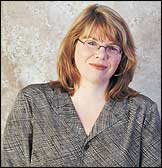by Martha Kerr
Last Updated: 2008-07-01 16:46:30 -0400 (Reuters Health)
NEW YORK (Reuters Health) – Quantitative heel ultrasound plus the presence of clinical risk factors may provide an easy, effective method of assessing the risk of osteoporotic fractures in elderly women, Swiss researchers report in the July issue of Radiology.
Dr. Idris Guessous and colleagues at the University of Lausanne conducted a 3-year prospective multicenter study to construct a prediction rule for assessing the risk of osteoporotic fractures in elderly women using clinical data and heel-bone ultrasonography. The study enrolled 6174 Swiss women between 70 and 85 years of age.
Stiffness index on ultrasound, a reflection of bone density, bone quality, architecture and elasticity, was used.
"The physical and mechanical properties of bone progressively alter the shape, intensity, and speed of the propagating wave," Dr. Guessous explained during an interview with Reuters Health. "Bone tissue may therefore be characterized in terms of ultrasound velocity and attenuation. These two parameters are combined to derive a third parameter, the stiffness index."
The investigators identified five clinical risk factors for osteoporotic fractures and assigned each factor a score. These included age older than 75 years (2 to 3 points); low heel ultrasonography stiffness index (5 to 7.5 points); a history of fracture (1 point); a recent fall (1.5 points); and a failed chair test (1 point).
Using a cut-off value of 4.5 points, a 90% sensitivity for fracture was obtained. With this cut-off value, 1464 women were classified as having a lower risk and 4,710 as having a higher risk for fracture.
Of the higher risk women, 6.1% had an osteoporotic fracture, compared with 1.8% of women at lower risk. Ninety percent of those with hip fractures were in the higher risk group.
"The benefit is that this risk assessment combined bone status and clinical risk factors, factors that have previously been shown to independently predict the risk of osteoporotic fracture," Dr. Guessous said.
"This risk assessment method also integrates risk factors for fall," the researcher pointed out. "Depending on which determinants predominate, for example, low stiffness index rather than a recent fall, physicians can identify the most appropriate interventions, such as balance retraining, hip protectors or bisphosphonate treatment."
"Because the prediction rule is simple and easy to use in practice, it might be a useful tool for physicians and therefore help to increase the general awareness for osteoporosis screening and detection," Dr. Guessous commented.
"A prediction rule that uses heel quantitative ultrasound, an inexpensive, transportable, ionizing radiation-free device that predicts hip fractures and all osteoporotic fractures in elderly women, would certainly be easier to adapt to the growing demand for osteoporosis management in the next decades."
Radiology 2008;248:179-184.
Copyright Reuters 2008. Click for Restrictions



